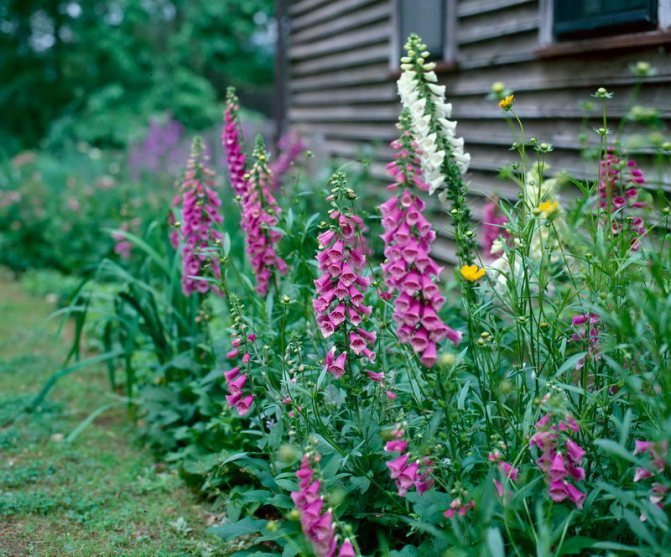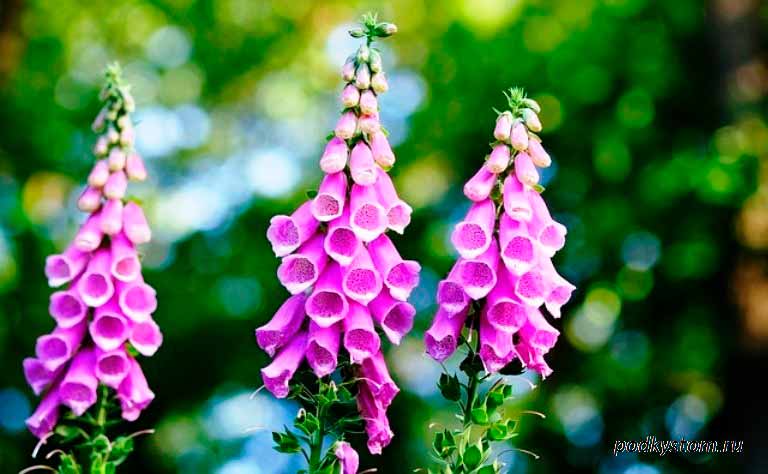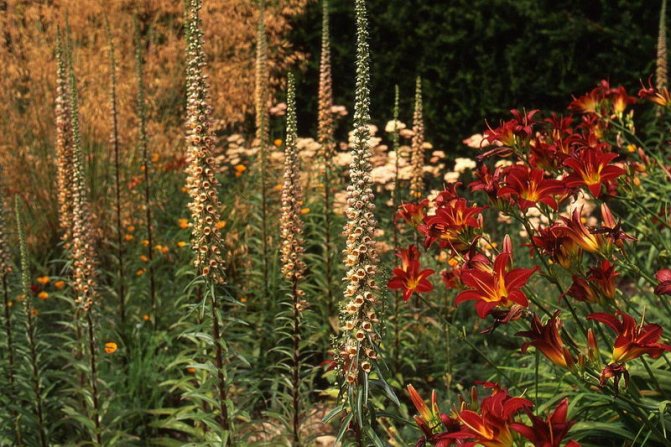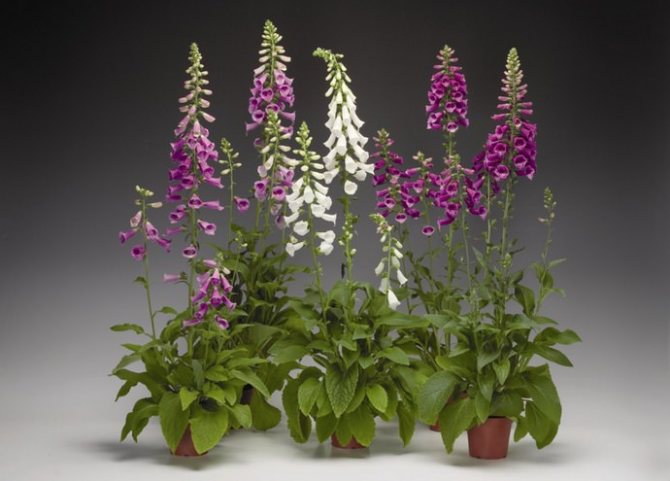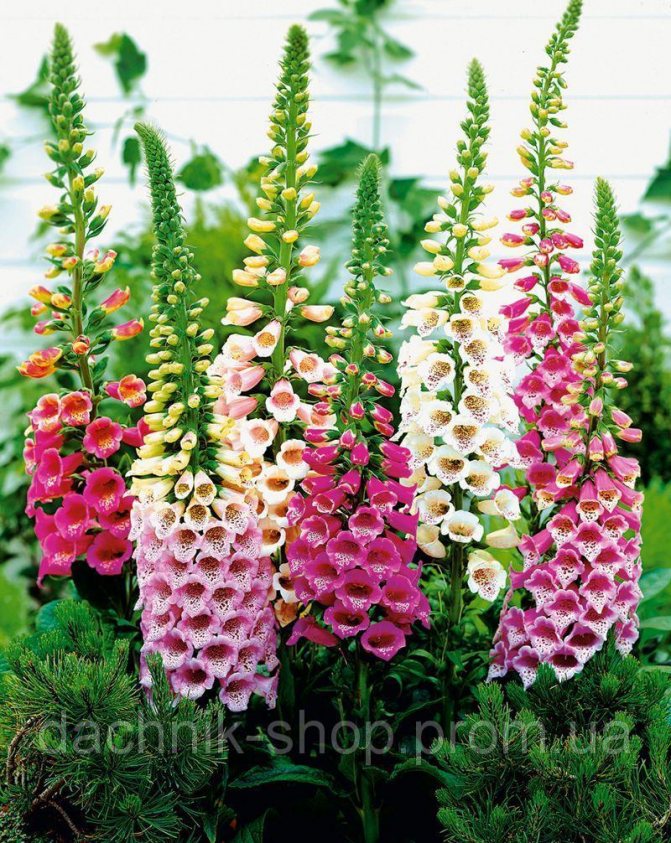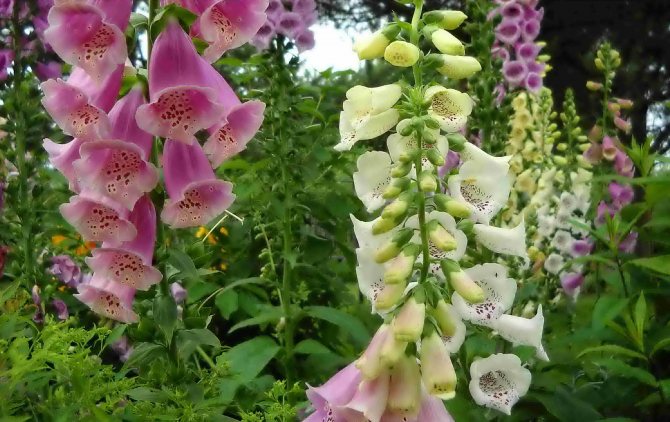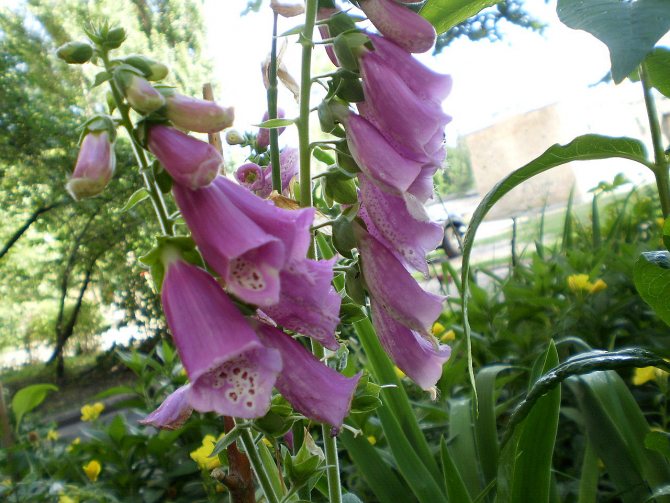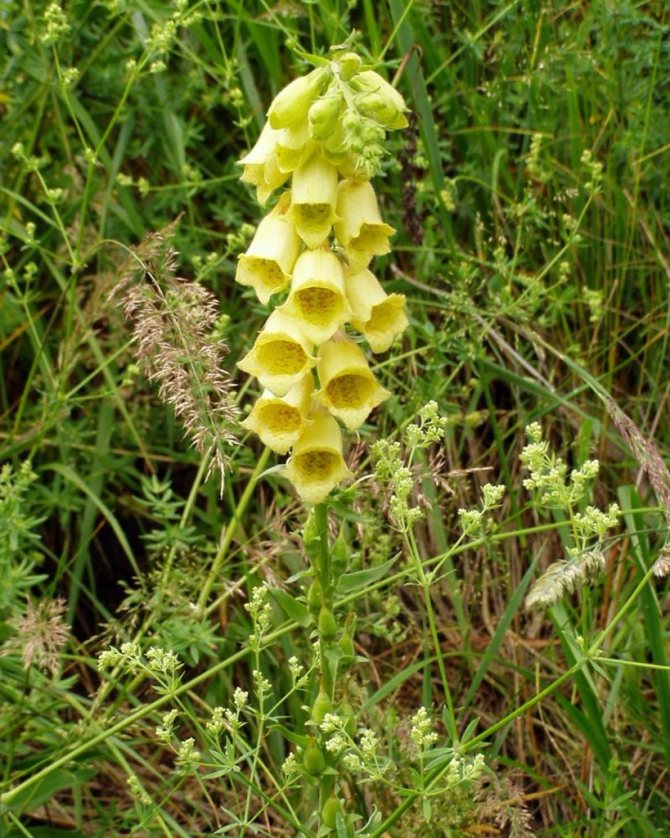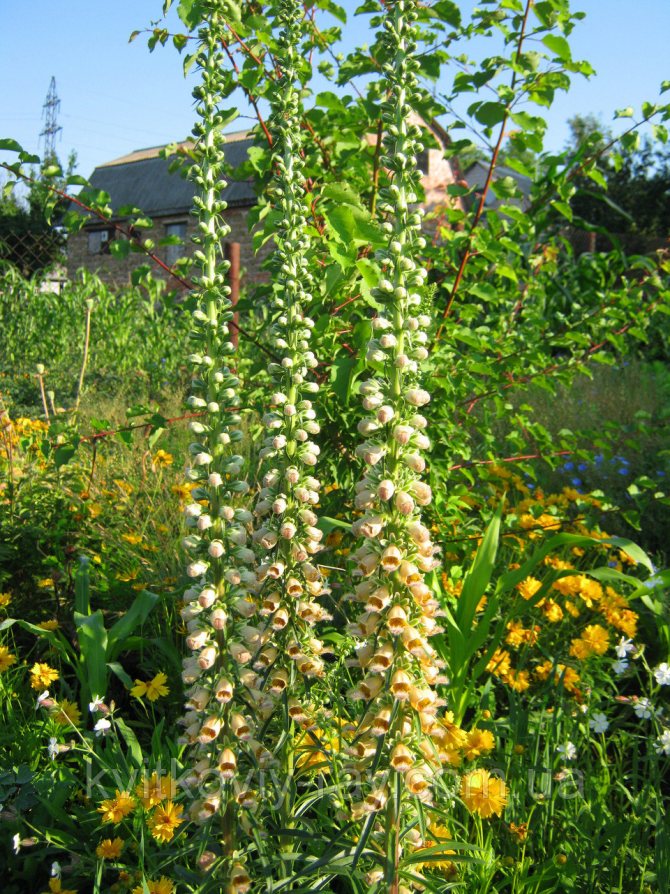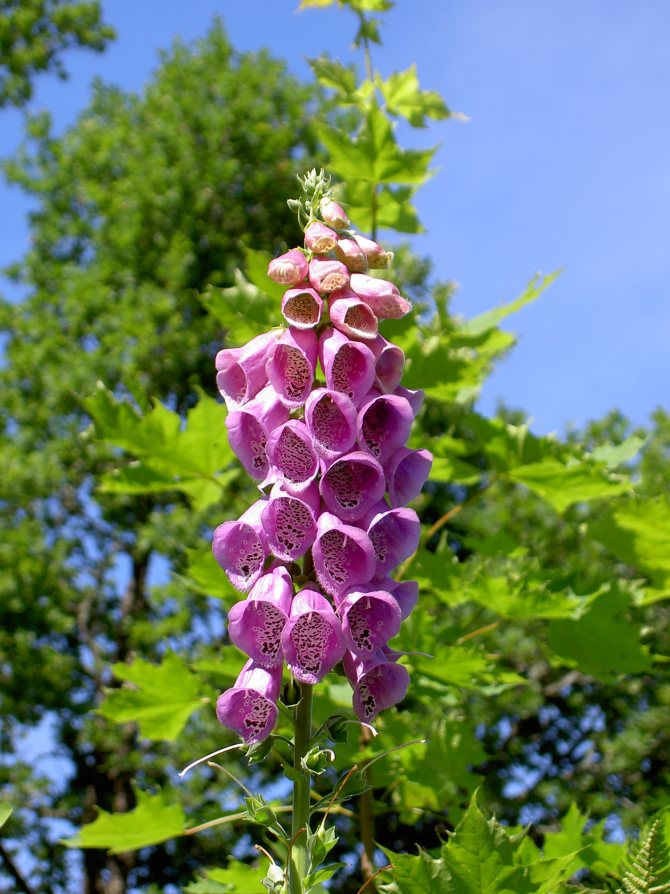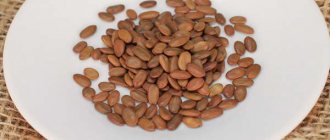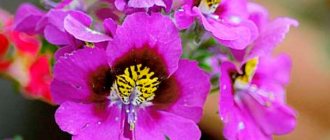Foxglove inflorescences, resembling bright candles from a distance, attract the eye with their luxurious beauty. But do not rush to touch or smell the delicate bells. Digitoxin, contained in the leaves and flowers of the plant, is not only a powerful cardiotonic and antiarrhythmic drug, but also a powerful poison.
Growing digitalis from seeds at home
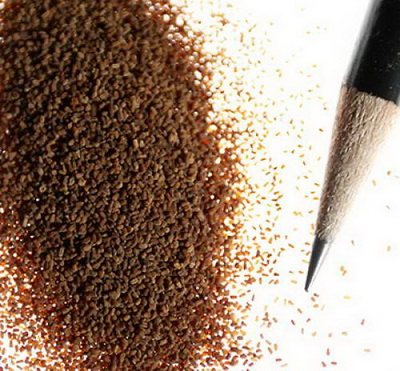
Foxglove seeds photo
Seeds can be sown outdoors or seedlings can be grown.
How to plant foxglove seeds in the ground
Sowing foxglove seeds in open ground should be carried out in the spring, as early as possible, as soon as the earth is ripe - from the end of March to the end of April, if you are late, it is possible in May. It is better if the bed is prepared in advance, the soil is well dug up and has time to settle. The surface should be leveled with a rake, the breasts should be split and raked onto the sides of the bed.
- Small seeds cannot be planted deeply, so make shallow rows so that the planting depth is no more than 1-2 cm.
- Sow in rows, keeping a distance of 25-30 cm between them.
- Spread the seeds as sparingly as possible, sprinkle a little earth.
- If the weather is cool, cover the crops with lutrasil, watch for emergence.
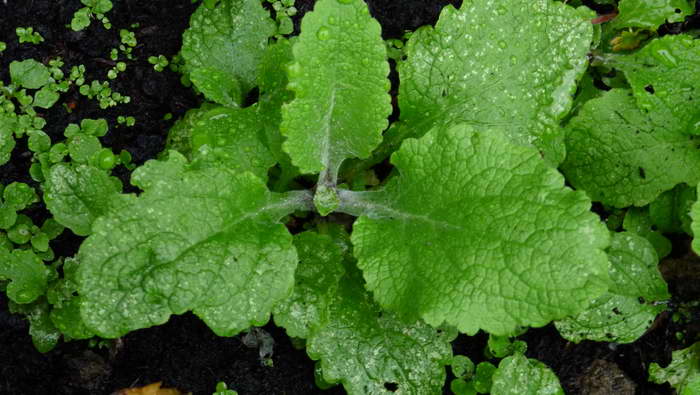

Digitalis growing from seeds when to plant in open ground photos of seedlings
- Thin the dense seedlings so that the plants can fully develop, leaving a distance of 8-10 cm.
- Later, plant the bushes at a distance of 20-25 cm for a continuous flowering row, or 40-50 cm for a single arrangement of bushes.
Foxglove reproduces well by self-sowing, so you don't have to worry about the sowing material, but simply choose the best "fallen" plants in the spring and plant them in a permanent place (but only if your digitalis is not hybrid).
Foxglove from seeds at home
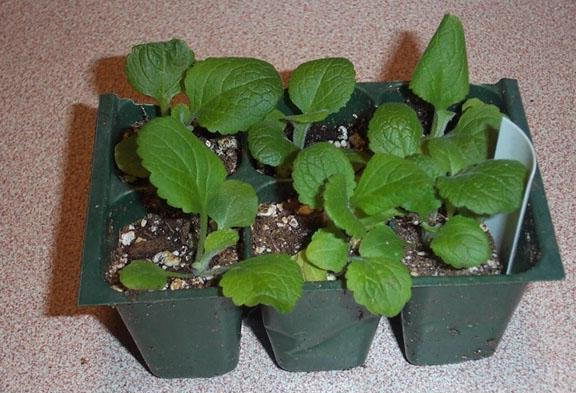

Digitalis from seeds at home photo seedlings
Sow digitalis seeds for seedlings from early to mid-March.
- Fill containers with light, loose soil, spread seeds over the surface of the soil, sprinkle with sand.
- You can spray crops with a growth stimulant solution to speed up and improve germination.
- Cover crops with glass or foil to create a greenhouse effect.
- Grow in a warm place with diffused lighting.
- Air the greenhouse, moisten the soil.
- Seedlings will appear in a couple of weeks, it is better to remove the shelter.
- The seedlings will develop slowly. When two true leaves appear, plant them in separate pots or in a larger box, keeping a distance of about 10 cm between the plants.
- It is not difficult to care for the seedlings: water as the soil dries up, gently loosen the soil, protect from direct sunlight and drafts.
- Seedlings are planted in open ground with the establishment of real heat: late May-early June. Temper the seedlings a couple of weeks before. Bring it out to fresh air daily, increasing the residence time every day.
Foxglove will grow best in an open, sunny area. It will normally feel in the shade, but it is important not to allow moisture to stagnate, otherwise the plant will not bloom or even die.
The soil is necessary nutritious, loose, without stagnant water.
Open ground
May is the time to start sowing seeds.
The seeds are so small that when sowing, their superficial placement will be quite enough, but with sprinkling not soil, but sand.
To accelerate germination, the sowing site, especially in cold weather, can be covered with a covering material.
After the formation of seedlings, they must be cut open, and already towards the end of August they can be planted on a selected area, observing a distance between them of 30 cm.For residents with severe winters, it is better to place the grown plants in a container with a diameter of 10-11 cm in autumn and send them for winter storage into a well-lit dry basement. But already with the arrival of spring, transplant it safely into the ground.
How to plant seedlings in the ground
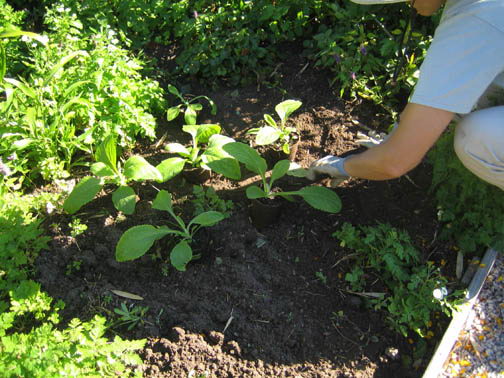

How to plant digitalis seedlings in the ground photo
Dig up the area to the depth of the shovel bayonet, add compost for digging at the rate of 4-5 kg per square meter. Make holes for the size of the root system and transfer the foxglove along with the earthy clod. Observe the distance between plants in a row of 20-25 cm, between rows - 25-30 cm. Compact the soil, water.
In the first year of life, the green mass will grow, and flowering will come in the next season.
Fertilization
In order for self-seeding to reproduce successfully, it is important to maintain a favorable soil condition for this. For this purpose, fertilization is regularly applied to the soil.


Flowerbeds with foxglove by garden paths
In the spring of the second year after planting, foxglove is fed with mixtures containing phosphorus, potassium and nitrogen. In addition, complex nitrogen fertilizers are applied twice in the summer season.
Planting digitalis in your summer cottage will be an excellent alternative to perennials that are more demanding to care for. Once having planted a plant, the florist will be relieved of the hassle of reproduction, and the garden will always burn with bright candles of flower stalks.
How to propagate digitalis with lateral processes
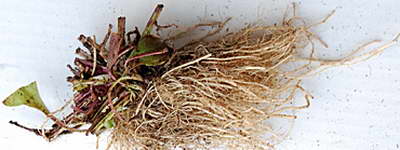

Foxglove root photo
Digitalis is propagated by basal processes. After flowering, cut off wilted inflorescences. After 2-3 weeks, young shoots will appear at the base of the root. When there are 7-8 leaves on them, carefully separate them from the main plant and transplant. By the beginning of the cold weather, they will take root, and in the next season they will bloom.
Digitalis: planting and care
Before planting the bushes, the soil is dug up and enriched with manure or compost and mineral fertilizers. You can use "Nitrofoska" or add 1-2 glasses of wood ash to the holes.
Caring for adult plants is simple. Watering is done only as needed, since the flower does not like excessive moisture... The soil around the bushes should be regularly weeded out and loosened from time to time. The foxglove roots are horizontal, so loosening is done very carefully.
Plant care includes feeding two or three times per season. Special mineral fertilizers are used for flowering flowers. Overfeeding the foxglove is not recommended, otherwise you can get a lush plant without flowers. Faded and wilted flowers are removed from flowering bushes. In this case, flowering will last longer. Inflorescences that have already completely bloomed are cut off.
When caring for foxglove, it is recommended to look at the condition of the roots. By the end of summer, they can crawl out. In the fall, they must be sprinkled with a thick layer of soil., otherwise, in the winter cold, the root system will freeze and the plant will die.
With proper care, seeds will ripen on the plant in the fall. In this case, the adult plant reproduces by self-seeding, which facilitates its reproduction.
How to care for a foxglove in the garden
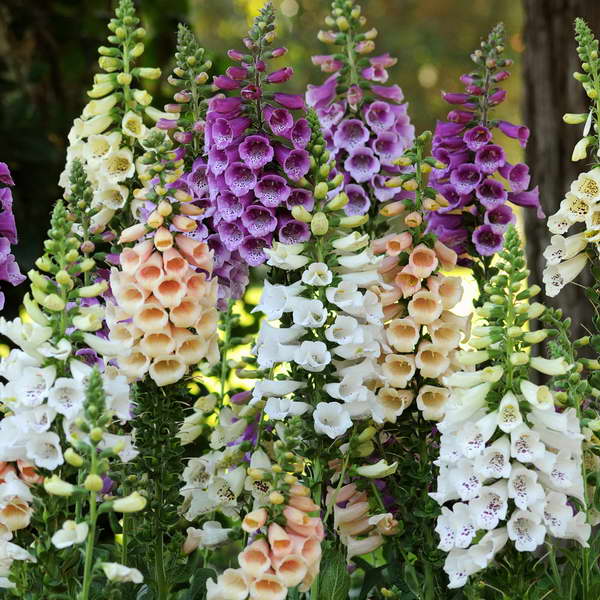

Foxglove flower hybrid photo of the Dalmatian variety
Water only during periods of prolonged drought, the plant can be content with precipitation.
After watering and rain, gently loosen the soil. Do not go deep, since the root system is superficial, it is easy to damage it.
Feed with complex mineral fertilizers a couple of times a season. Add them along with watering.
Remove wilted buds to make the plant look decorative. Leave only the most lush blooms for seed collection.
Care
Timely watering, weeding, feeding, protection from pests and diseases is required.
Watering
Moderate watering is necessary, but during the period of ejection of peduncles and flowering, the plant needs additional watering on the ground with warm water, without touching the leaves and stems, preventing its stagnation in the garden.
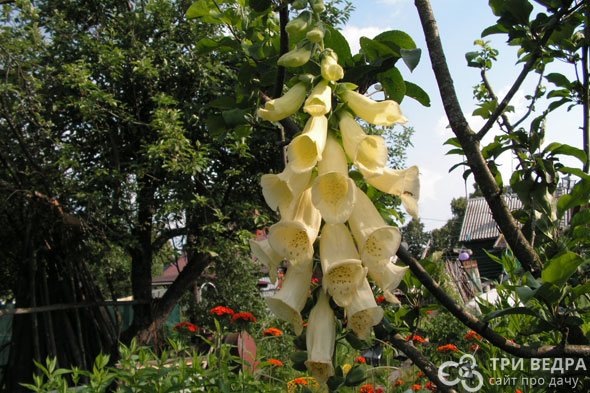

The foxglove plant is drought-resistant, but when transplanting, watering should be monitored especially carefully, because broadleaf rosettes evaporate a lot of moisture in hot weather and can die without water.
Top dressing
To provide nutrients, the foxglove must be fed during the period of flower stalks and budding, using the complex fertilizer Agricola (15g - 10l of water) and nitrophosphate (20g - 10l of water) per 1m².
Foxglove after flowering
Collect seeds if necessary. When the seed pods are fully ripe, they will take on a dark yellow, brown hue. The best seeds are in the pods located at the bottom. Take them off before they burst. Pour the seeds onto a newspaper and dry them in a well-ventilated area. Store in paper bags in a dark, dry place.
Often the roots of the plant can protrude to the surface - sprinkle them with nutritious soil for the winter. Cut off the stems, leaving about 10-15 cm above the surface. Mulch the soil with sawdust, dry leaves, cover with spruce branches.
Foxglove application
Powder from leaves and flowers, tablets, tinctures and tinctures of foxglove are used for chronic heart failure, valvular heart disease and other cardiac disorders. The use of digitalis in medicine is due to the presence of cardiac glycosides in its chemical composition.
Digitalis reduces congestion, increases blood flow rate, lowers heart rate, relieves swelling and shortness of breath, and increases urination.
In decorative gardening, foxglove is used in combination with other biennials or annuals, forming beautiful flowering high borders.
See how the foxglove looks and grows in the video, where descriptions of the types and methods of agricultural technology are presented:
Diseases and pests
Powdery mildew, spotting are diseases from which the plant can be saved. It is necessary to remove the affected areas, treat with a fungicide. Measures need to be taken in the initial stages. With a strong infection, the plant will have to be destroyed.
If root rot, viral mosaic is affected, the plant will have to be removed and burned in order to avoid contamination of the rest of the plants on the site. Treat the soil with a fungicide.
Various types of aphids can harm digitalis. If pests appear, treat with an insecticide.
Botanical description of foxglove: what a plant looks like (with photo)
Starting the description of the foxglove plant, it is worth mentioning that it owes its name to a drooping, rounded flower resembling a thimble. The plant is not difficult to grow. Gardeners love this flower very much for the great decorativeness of the whole plant.
Continuing the botanical description of foxglove, let's say that in floriculture it is more often grown as a biennial. Digitalis is very decorative, its inflorescences consist of many bell-shaped tubular flowers 3-4 cm long, white, pink, purple, red and cream in color with dark spots on the inner side of the corolla. Foxglove leaves develop in the first year in the form of a basal rosette, they are large, light green in color. When cut off faded inflorescences, it forms new flower arrows. In varietal digitalis, the length of the inflorescence reaches 40-60 cm, and the height of the plants is from 60 to 150 cm. It blooms from June to August.What a foxglove looks like can be seen both in wildlife and in the images accompanying this article.
Foxglove is planted in the sparse shade of young trees, against the background of tall shrubs, in the background of prefabricated flower beds, in single and group plantings. In the cut, it costs up to 10 days.
Studying foxglove from a photo and description, you can only get an initial impression of the culture, but it is also enough to make a decision about growing a plant on the site:
Types and varieties of foxglove with photos and names
Digitalis purpurea perennial Digitalis purpurea
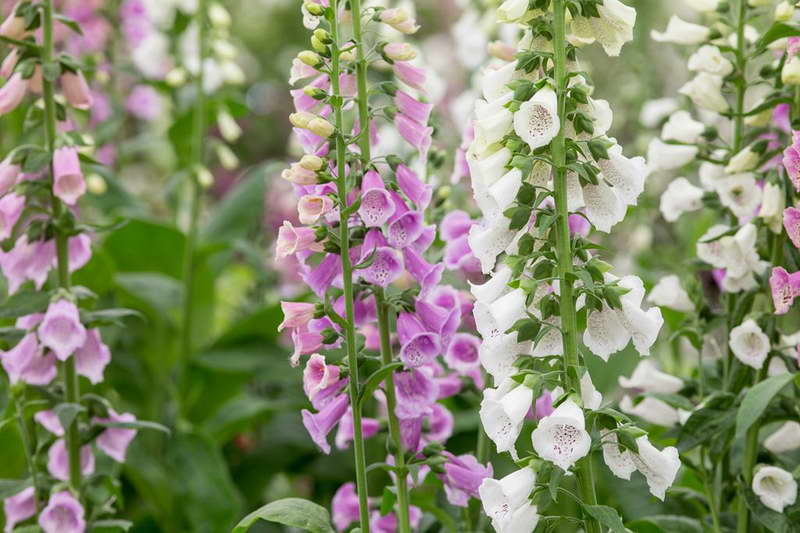

Digitalis purpurea perennial Digitalis purpurea photo
Perennial. The plant is 1.5 m high, with about 80 cm covered with flowers. Stem erect, weakly branched, densely pubescent. The lower part of the stem is covered with elongated long-petiolate leaves, arranged alternately, the upper leaves are sessile, rounded, all leaf plates are pubescent. The length of the corolla is 5 cm. The color can be white, cream, pink, purple, fiery red, inside the corolla a smear of a darker shade. The inflorescence is one-sided.
Varieties of the species are the foxglove gloxiniform and spotted.
Varieties:
The Shirley - one-sided inflorescence consists of drooping pink corollas with a cream or purple spot inside;
Excelsior Hybrids Mixed - large flowers, arranged in a spiral, white, pink, red;
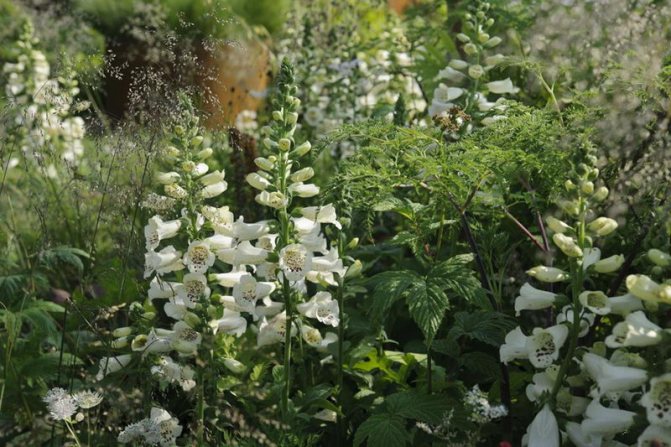

Digitalis purple variety Alba Digitalis purpurea ‘Alba’ photo
Alba - snow-white flowers, grows well in moist soils;
Snow Thimble - plant 1.2 m high, white flowers;
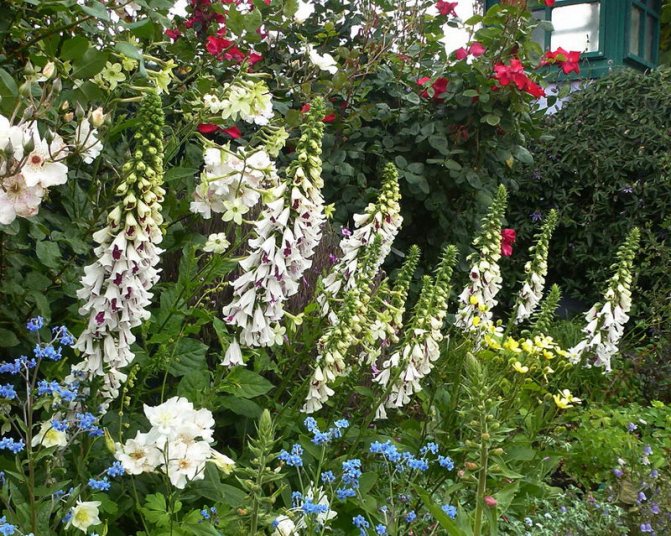

Digitalis purpurea Pantaloons Pam s Choice Split variety of digitalis purpurea in landscape design
Pam's Choise - snow-white corollas with spots inside a cherry hue;
Pam's Choice Split Corolla - orchid-like carved corolla;
Pink champagne - attracts with delicate colors;
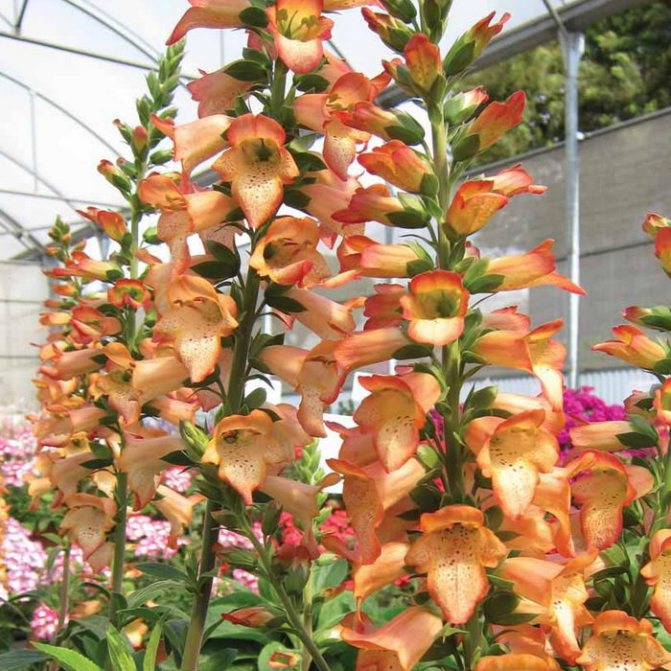

Digitalis variety ‘Illumination Apricot’ photo
Apricot - apricot-colored flowers;
Glittering Prizes Mix - colors from white to burgundy;
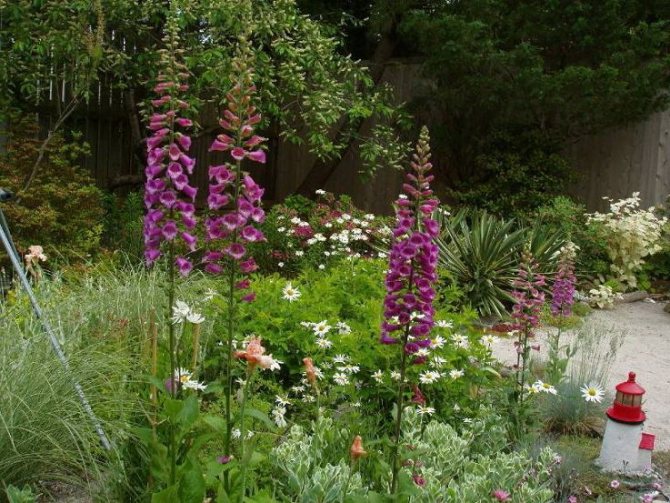

Digitalis purpurea Dwarf Red variety in the garden design photo
Dwarf Red - a plant about 70 cm high, flowers are bright pink;
Fooxi - plant height is 80 cm, flowers are white, pink, purple, bright red.
Large-flowered digitalis Digitalis grandiflora or Digitalis ambigua


Digitalis grandiflora or Digitalis ambigua photo
The plant is 1.2 m high. The leaves are lanceolate, the oblong edges of the leaf plates and the veins are pubescent. Corolla length is 6 cm. They are yellowish, inside there are streaks of dark brown color, the surface of the corolla is pubescent.
Domestic varieties:
- Carousel - foxglove about 120 cm high with cream flowers;
- Apricot beauty - reaches a height of 1.4 m, the color of the corollas corresponds to the name;
- The white giant is a tall foxglove with white flowers;
- Spotted giant - white flowers with spots of a purple hue;
- Yellow - has yellow flowers;
- Lilac giant - flowers of a lilac hue;
- Speck - bright crimson flowers with burgundy specks.
Rusty digitalis Digitalis ferruginea
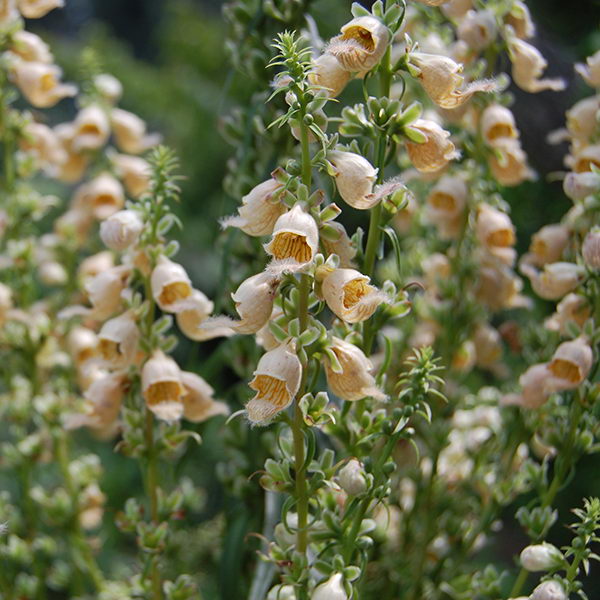

Foxglove rusty Digitalis ferruginea photo
Plant height is 70-120 cm. Leaves are oblong, glabrous or slightly pubescent. The corolla has a pronounced lower lip - like an orchid flower. Color from pale yellow with a pinkish tinge, yellow-gray, rusty, golden brown. Inside the corolla there are veins of a lilac, reddish-brown hue.
Woolly foxglove Digitalis lanata


Woolly foxglove Digitalis lanata photo
Medicinal plant. The flowers are small, yellow-brown with purple veins. The stem is densely pubescent.
Foxglove yellow Digitalis lutea
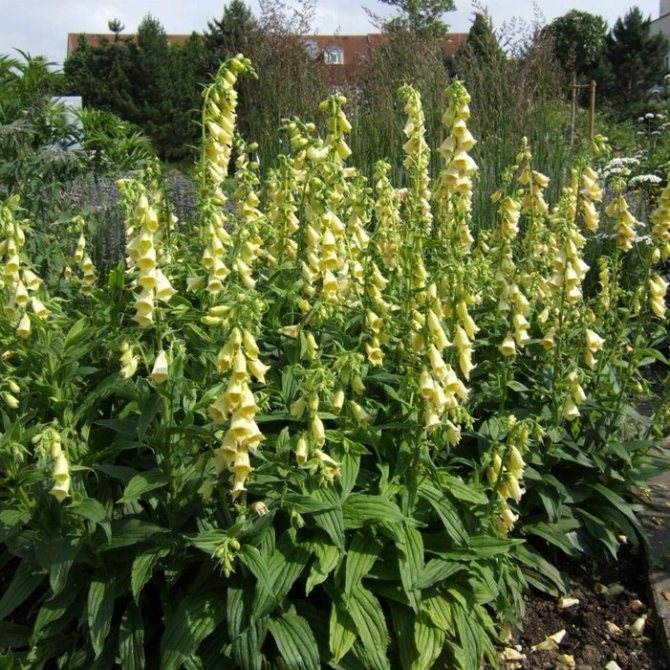

Foxglove yellow Digitalis lutea photo
Height is 80-100 cm. Leaves and stems are glabrous. The leaf plates are oval-oblong. Flowers have
Gelb Janus is the most popular variety with pale yellow flowers.
Description of the plant
Digitalis, or Digitalis (Digitális), belongs to the genus of herbaceous plants of the plantain family. The unusual flower has many popular names - in Ireland it is called witch's thimbles, in Germany - elf hats, in France - gloves of the Virgin Mary, etc.
There are more than 30 plant species growing mainly in the Mediterranean countries, where not only herbaceous (one- and two-year) varieties of foxglove are found, but also shrubs and dwarf shrubs. The plant is also quite common in Europe, the Caucasus, Ukraine and the European part of Russia, West and North Africa.
Low rosette consists of large lanceolate leaves covered with hairs below. The straight stem (peduncle) in biennial and perennial species reaches 150 cm. The flowers of the plant, collected in the form of a one-sided or multilateral brush, are located in the upper part of the peduncles. The bell-shaped cup resembles an old thimble. In some species, the bell-shaped flower is so elongated that it looks more like a finger.
The flowers can be bright purple, deep purple, light orange, pale lemon, yellow or white. Flowering begins in early June and lasts until the end of September. The fruit resembles an oblong-ovoid capsule with a large number of small light and dark brown seeds that remain viable for no more than 3-4 years. One plant produces more than 2 million seeds per season.
Digitalis in landscape design


Rusty foxglove in landscape design photo
Tall species and varieties serve as a backdrop in linear flower beds and mixborders, plant them to cover unsightly walls. Medium-sized ones are good for decorating flower beds; with the help of undersized ones, frame curbs, paths.
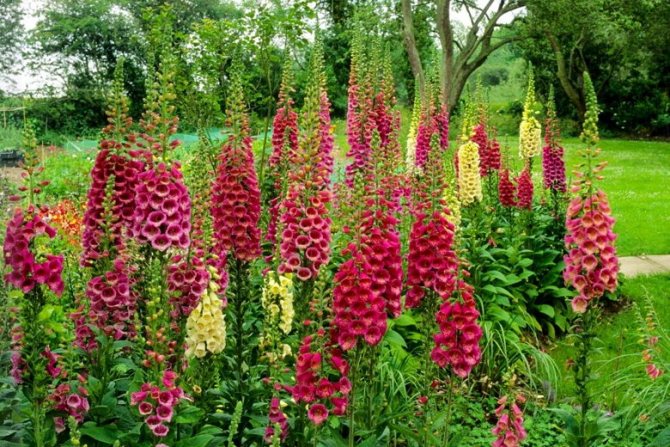

Digitalis in landscape design photo flower beds
Can be planted in flowerpots or pots to decorate terraces, balconies.
Create a clearing of foxgloves in the garden - it will look gentle, romantic, natural.


With what flowers to plant a foxglove photo of a mixborder
Shrubs and trees will be good partners in the garden: viburnum, wild rose, honeysuckle, rhododendron; shade-tolerant plants: hosta, primrose, geranium, aquilegia, dicentra; universal neighbors: irises, decorative onions, peonies, poppies, angelica, valerian.
Cut flower stalks delight for about a week. They look great in tall ceramic and glass vases.
Types of foxglove
The most popular species is the purple foxglove. It is a biennial plant with powerful leaves and pinkish-red petals, strewn with specks from the inside. This perennial, by the way, is widely used in homeopathy. Representatives of this species are completely undemanding in care and delight with flowering for more than a month. Unfortunately, foxglove purple doesn't live for many years. In the third year, the plant may not die, but, most likely, it will lose its decorative effect.
Other varieties are more often grown as perennials. Among them there are tall specimens (up to 180 cm), medium-sized (65-100 cm), as well as charming dwarf varieties (30-60 cm).
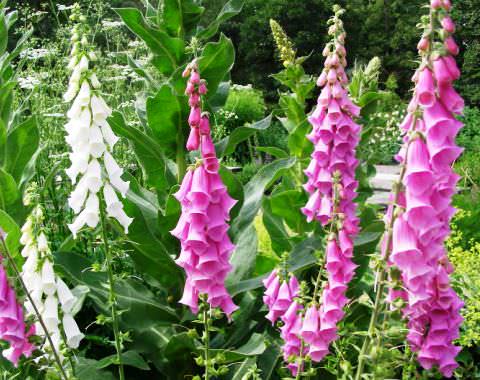

In the large-flowered foxglove, the petals are pubescent, of a delicate pastel yellow color with brown specks. It rarely grows above 120 cm, is considered a perennial, but can behave like a biennial. A great option for decorating gazebos, verandas, planting in pots, making chic bouquets.
The foxglove is yellow even lower, up to 100 cm in height. It is a full-fledged perennial that tolerates cold well and is suitable for garden plots in northern latitudes. It will help to create an impressive yellow-orange range in the flower garden, it goes well with plants that bloom in purple, blue and red.
Rusty foxglove has very unusual flowers, usually they are painted in various yellow-brown tones, resembling an orchid in shape. This species is just a godsend for gardeners who cannot devote much time to caring for the site. The plant needs moderate watering and a little feeding. Varieties of this species are often used to create multi-tiered flower beds and natural thickets.
Medicinal properties of digitalis and contraindications
Leaves are the main medicinal raw material.They are rich in glycosides (biologically active substances that help in the treatment of cardiovascular diseases). Foxglove has been used in traditional medicine since the 18th century. Powdered leaves are used in medicines.
In folk medicine, infusion is used. It has long been taken for epilepsy, as a pain reliever and a means to cleanse the body.
For a long time, with the help of foxglove, healers treated epilepsy, abdominal and thoracic dropsy, used it to relieve pain in skin diseases, as well as a remedy for constipation and to cleanse the body. However, with the wrong dosage, vomiting, diarrhea, and often death were observed. Therefore, for a whole century, humanity has forgotten about foxglove.
The plant is very poisonous, so the infusion should be taken under medical supervision. Call an ambulance at the first sign of poisoning. Poisoning is manifested by nausea and vomiting, severe abdominal pain, rashes on the skin, convulsions, respiratory failure and heart failure are possible. Long-term use leads to a cumulative effect of toxic substances, which may lead to loss of appetite, hallucinations.
It is strictly forbidden to take foxglove to children, pregnant or lactating women, as well as to people who have had myocardial infarction, who have lung diseases, who suffer from pericarditis, angina pectoris, and gastric tachycardia.
Plant history
Many legends and superstitions are associated with the foxglove, mystical properties were attributed to it. The medicinal properties of the plant have been known since ancient times. It is believed to have been used for medicinal purposes long before our era. Extracts and infusions from digitalis until the 18th century were used mainly for the treatment of dropsy of various origins and epilepsy.
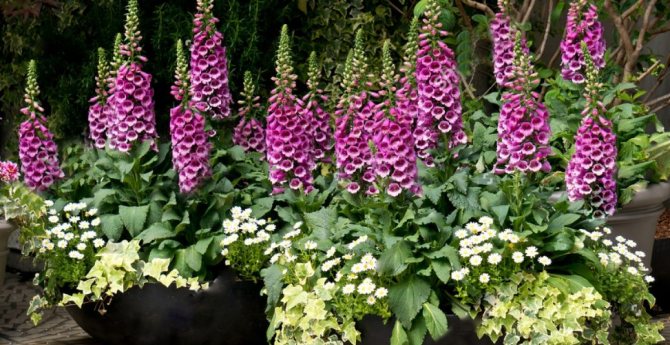

The name of the plant that has come down to us was given by the German physician Leonart Fuchs, who described it in a herbalist in 1543. But for a long time, official medicine of that period was wary of the foxglove. Due to the inability to determine the exact dosage of the drug, there were frequent cases of poisoning, therefore, from time to time the use of digitalis was prohibited, and it was excluded from practice.
In 1776, the English physician William Withering discovered the digitalis glycoside, and foxglove began to be used as an indispensable heart remedy. In the Russian Empire, Digitalis was described in 1866 in the first edition of the Pharmacopoeia. The great Russian doctor S.P. Botkin called foxglove "one of the most precious remedies that therapy has."
Description


The digitalis is native to Central Asia and Southern Europe. Height, up to 1.5 m. Flowering date, June August. Flower color, white, cream, pink and purple, with spots in the tube. A place, can grow in a sunny or slightly shady place. The optimal place is to guarantee the sun by 10 o'clock in the morning.
Healing properties of leaves
The healing properties of the plant have been known since the Middle Ages; the leaves of foxglove purple are used in folk and official medicine. They are cut off without petioles, in this part there are no useful substances. On plantations in the first year of cultivation, harvesting begins in July. During the season, the leaves are cut 2-3 times. Dried quickly, in an open container at a temperature of 55-60 °. In the second year of life, the collection is carried out once after flowering.
Advice. Collect raw materials on a sunny day, glycosides accumulate under the influence of ultraviolet radiation.
The aerial part of the thimble grass contains many chemical compounds used in medicine:
- 60 cardiotonic glycosides;
- organic acids;
- flavonoids;
- choline;
- saponins and other active substances.
The leaves are widely used for the preparation of cardiac drugs in the form of tablets, powders, tinctures.
Medicinal plant
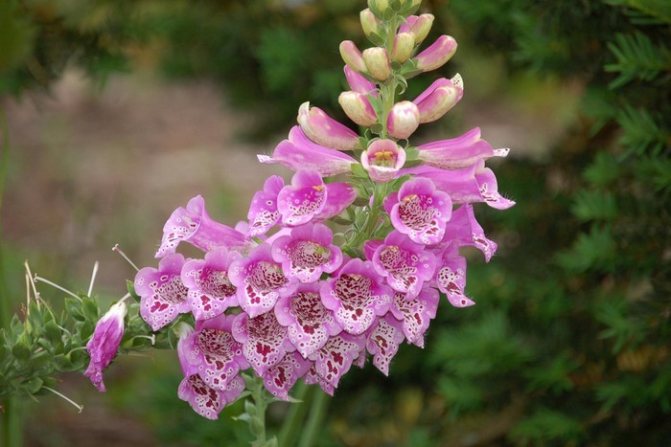

Herbal raw materials: leaves (Folium Digitalis purpureae).Harvested from annual plants in sunny weather, then dried.
Action: contains saponins, mucus and cardiac glycosides. The most potent is digitoxin, which is used to treat neuroses and heart disease. Currently not used in herbal medicine. Used by foxglove woollyless toxic.
Recommendations for the care of such flowers
Lush flowering for two to three months can only be provided with good care, and even such an unpretentious plant as a foxglove will be grateful for the attention and care.
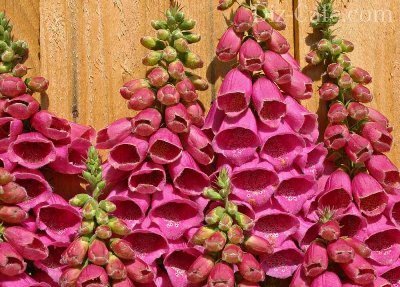

Foxglove air thickets easily play the role of a "human shield". If there is an old barn or an unsightly fence in the country, they will cover up flaws with their lush flowers, distracting attention.
Choice of soil and lighting
The ideal soil for foxglove is loose, moderately moist, well-fertilized fertile land. A plant planted in an arid place will never produce lush and bright peduncles, and a plant located in a swampy area will soon die due to root decay. That is why you should regularly monitor the soil moisture and, if necessary, water it additionally, preferably at night.
The material on how to make a timer for watering will also be useful:
If the roots of the plant are in a comfortable, humid and breathable environment, sunlight does not matter much: the culture gains color equally well in a lighted flower bed and in a semi-dark garden. Foxglove is one of the thriving and brightly flowering plants used for shady zones, so it is actively used to create the so-called natural forest thickets.


Unusually bright colors for a shady forest and large sizes make the foxglove a favorite among plants traditionally planted in park and garden areas.
In addition to regular watering, flowers need weeding, loosening the soil, timely fertilizing with mineral fertilizers (2-3 times during the season is enough). Around the end of summer, it is necessary to monitor the condition of the roots: some of them are exposed, crawling out. With the arrival of autumn cold weather, the roots must be sprinkled with a dense layer of soil so that they do not freeze. In autumn, the seeds of the plant also ripen. With proper care and protection in "wild" plantings, foxglove reproduces remarkably by self-seeding, therefore, measures for collecting seeds, storing and planting them are not needed. If it is nevertheless necessary to collect seeds, then during flowering it is necessary to select the best specimens and mark them.
Protection against diseases and pests
The foxglove, wild or ornamental, sometimes suffers from diseases common to large plants. Some of them heal quickly. For example, if you see small spots on the leaves, then the plant urgently needs to be fed with a fungicide solution containing copper. Mosaic patterns and twisting of leaves, as well as rotting of the peduncle or roots indicate an incurable disease, in this case it is better to isolate the plant and destroy it before the surrounding individuals become infected.
In addition to white and gray rot, the plant is exposed to such misfortunes as downy mildew, nematodes, viral diseases, various types of moths and aphids. The drug "Vitaros" (2 ml per 1 liter of water for irrigation) fights well against diseases, and "Iskra" (1 tablet per 10 liters of water) fights against aphids.


"Vitaros" suppresses many types of external and internal infections for 2 days. The cost of 1 package of 10 ml is 55 rubles
Overdose
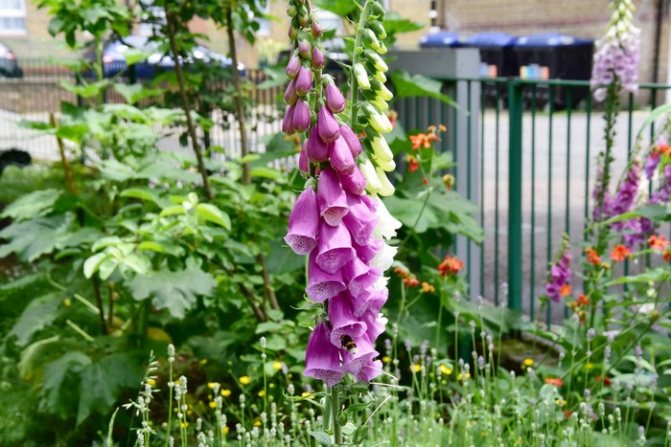

An overdose of digitalis drug is manifested by cyanosis, shortness of breath, tinnitus and visual impairment. Often cramps, gastrointestinal colic, nausea and vomiting.
Digitalis interacts with many substances, it cannot be taken together with penicillin, quinidine, calcium supplements, vitamin C, salicylates, neomycin, corticosteroids, theophylline, verapamil, spironolactone.
In the event of an overdose, hospitalization becomes necessary.
Self-collection of foxglove seeds and their selection for sowing
Foxglove seeds are easy to collect on your own. But it will not be possible to collect at one time: the seeds of this plant ripen unevenly, they are collected in the same way, gradually removing ripe, brown or yellowed capsules, starting from the bottom of the inflorescences. The quality of foxglove seeds decreases as they move up the inflorescences, so you can limit yourself to collecting bolls only in the lower part. You need to have time to collect the seeds before they start to spill out.
A huge number of small seeds are collected from one plant, which germinate the better, the fresher they are used. Despite the fact that the germination rate is reduced to 50%, it lasts for 2 - 3 years. The collected foxglove fruit capsules are dried in a dry ventilated room, and only then the seeds are removed from them. Store them away from light, heat and high humidity.
When buying foxglove seeds, it is better to trust trusted producers. Often, under the name of varietal digitalis, completely different plants grow from cheap seeds, the species are replaced with one another, and their characteristics are not accurate. Selecting growers familiar to you, tested on seeds of other perennials and annuals, will reduce the risk of a bad purchase. But the key is still to check the timing and time of collection: it is better to buy foxglove seeds harvested in the current or last year.
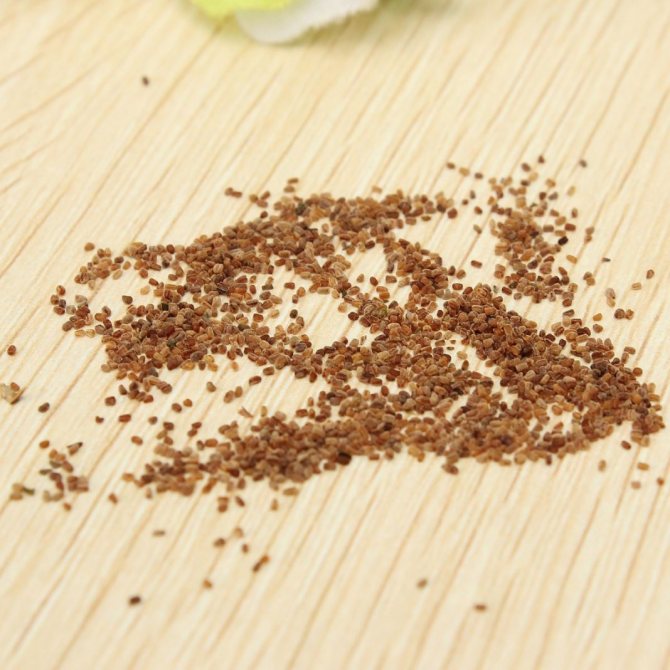

Foxglove seeds. <>
Autumn care, collection and storage of seeds, wintering
Perennial tolerates cold quite well, you do not need to dig out plants from the ground, like some beautifully flowering species. With the onset of autumn, the stems are shortened almost to the root rosette, the rhizomes are sprinkled with a layer of soil, a layer of spruce branches or fallen leaves is spread over the overgrowth. With good shelter, the ornamental plant does not freeze out.
Experienced growers advise to collect seeds from the lower boxes: in this zone, the planting material is of higher quality and "strong". The fruit should be brown or yellowish brown, not bursting. After collecting, the seeds are certainly dried on a sheet of paper. The seeds are stored in a cool room, where there is no dampness. Planting material collected in the fall can be planted on the site in the spring.
Possibility of poisoning
Only using the plant yourself is prohibited. All types of digitalis are poisonous, they contain many complex glycosides (especially in foliage). These substances have a strong effect on the heart. If a person is poisoned with foxglove, then his pulse slows down, flickers in his eyes, his head hurts, his face turns pale. Sometimes poisoning is accompanied by nausea, vomiting, diarrhea, fainting. It should be remembered about the dangers of self-administration of drugs with digitalis and entrust the dosage to an experienced specialist.


Reproduction
A beautifully blooming species on the site is bred both with seeds and with the help of root shoots. Each method has advantages and disadvantages. Vegetative propagation is easier, flowers appear faster, there is no such hassle as growing seedlings (seedlings).
Seeds
There are two flavors of the method:
- sowing in open ground. The method is suitable for warm, southern regions. In early May, planting material is sown in holes about 1 cm deep, the interval between the grooves is from 15 to 20 cm.Do not rush and plant seeds in the ground earlier, for example, in April, if there is a risk of a cold snap. When the temperature drops, the site must be covered with a special agrotechnical material, which can be easily removed during warming;
- growing seedlings. First, the seeds are soaked in warm water, then the "grains" are sown in a wooden box. The soil is nutritious, based on peat. Fine-grained sand gives looseness to the substrate. After planting, the container is covered with glass, placed in a warm place for seed germination. Diffused light, rather than direct sunlight, is helpful to retain moisture. Sprouts appear in 10-14 days.A pick is performed when there are 2 true leaves on the seedlings.
Root shoots
A simpler method, which is more often practiced by flower growers, especially in the early stages of mastering the wisdom of growing ornamental crops. After cutting the wilted inflorescence, lateral processes are formed. When the young shoot has seven to eight leaves and its own root, you can carefully dig out the shoots, transplant to another site.
The composition of the soil and growing conditions are the same as for adult plants, but more attention should be paid to the new specimen. After the end of the adaptation period, when the plant gets stronger, problems practically do not arise. In September, the foxglove grown from the lateral growth is ready for wintering. The first bell buds on the pyramidal inflorescence are formed next spring.
Choose the right variety and seeds
Gorgeous plants can be obtained if you know everything about foxglove, planting and caring for it in the open field. First, pay attention to the variety and planting material. There are annual, biennial and perennial varieties. All types of foxglove are classified according to the height of the stem:
- dwarf varieties capable of reaching a height of up to 60 cm;
- medium-sized plants up to a meter high;
- tall varieties with one and a half meter stems.
Shops offer a fairly wide selection of foxgloves with a variety of flower colors. Many people prefer purple seedlings. It is a self-seeding biennial. A characteristic feature of this species are dense specks on the throat of opening bells. Many experienced growers collect seeds from proven varieties on their plots. Foxglove sows itself over long distances and grows well.
Digitalis Muse, Pearl and other varieties in garden decor
The purpose of a perennial in garden design depends on its size. Tall plants with large flowers are planted in mixboards and flower beds. These include the variety "Muse" with long light pink, lilac-lilac, yellow clusters and cultivar "Pearl" - a white and creamy garden beauty. In flower beds, they look spectacular in the center, framed by lower crops.
Medium-sized specimens ("Carousel") are the best decoration for walls and covering fences. Dwarf flowers are suitable for planting along curbs, paths, ridges.
Blooming pelargoniums, roses, rhododendrons, honeysuckle can be good neighbors for them. In shaded and shady places, it is better to plant them next to hosts, primroses, geraniums, peonies, valerian and others.


Which breeding method is better to choose?
Seed preparation and cultivation
Each plant produces a large amount of foxglove seeds. They are harvested in the fall, when the boxes are finally ripe. The most complete seeds are contained in capsules, which are located at the bottom of the plant. It is necessary to choose the moment when the fruit has already turned dark yellow or brown, but has not yet burst. The seeds are carefully scattered on a sheet of paper in the shade to dry completely, and then carefully remove the remnants of the fruit. The collected seeds survive the winter well, and in the spring they are completely ready for planting.
In order for the seedlings to be friendly and fast, they pre-soak the seeds in a small amount of water. The second solution is to cover crops with lutrasil or film. The soil should be loose, light. No need to dig holes or furrows, just sprinkle the seeds with mud or peat a little. The rows should be located at a distance of 40-50 cm from each other, only in this case, adult plants will feel free. The emerging seedlings must be thinned: the less often the plants are planted, the higher their growth and the larger the peduncles. Spring cultivation of foxglove from seeds is the main method of propagation of a flower culture.


Seedlings appear at different times, depending on the type and air temperature - in the period from 8 to 15 days.They need to be shaded slightly and watered gently until they get stronger.
Propagation by basal processes
Leaving the largest and most lush flower stalks on the seeds, brushes from other specimens should be carefully trimmed and wait about 3 weeks. After this period, 6-8 small basal rosettes are formed near the base, which will soon give 7-8 small leaves. At this point, the sockets must be separated from the base and planted in the ground at the planned site.
When transplanting and watering, care should be taken that no water or soil gets into the core, otherwise the plant will die. Until the end of summer, the rosette will take root, give new leaves and will be ready to hibernate with adult specimens.To make the foxglove comfortably survive the winter, it can be covered with branches or fallen leaves.


Large buds of foxglove have many shades - from pale yellow to deep purple. The rich color scheme can be used both for creating multi-colored flower beds and for decorating buildings.
Thanks to proper care, already in the second year, the plant blooms with huge caps of bright flower stalks, turning a flower bed or garden into a piece of paradise.
Reproduction by shoots
Breeding of Digitalis, in addition to the generative method, is also carried out by separating the root rosettes of the plant.
The procedure is carried out in several stages:
- after flowering, the spikelet is removed on the plant (it contributes to the fact that new shoots grow at the base of the culture);
- after the formation of 8 full-fledged leaves, the sockets are separated from the source;
- planted in a flower bed and watered.
When replanting, it is important to ensure that no clods of earth or water get inside the outlet. This can lead to the death of the plant.
Biological characteristic
In the wild, digitalis is found in different countries of Europe, Asia, Africa. He loves mixed forests, forest edges, clearings, shrubs, meadows. Butterflies are very fond of the plant. It became a source of food for them. Insects hide from the cold in the flowers of digitalis, because the temperature inside the bells is higher than outside. While inside, bumblebees always smear their backs with pollen, which is then transferred to other buds. This is how pollination takes place. In some countries and regions of Russia, foxglove is included in the Red Book.
Where can one buy?
You can buy seedlings and seeds of perennial foxglove in the stores:
| Name of shop | Amount in a package | Price |
| All Grades | Seedlings in a pot up to 0.5 l | 175 RUB |
| Gardens of Babylon | Seedlings in a container of 2.5 or 7 liters | 900 - 1650 rubles. |
| Becker | 1 rhizome | 249 r |
| Regmarket | On average 100 - 1000 pills per pack | 20 - 4850 rub. |
| Seedspost | 0.1 g | 16 - 18 rubles. |
Unpretentious foxgloves will decorate any garden plot and, with proper care, will delight owners with their paints for many years.
Photo gallery
Basic care measures


Foxglove: Photo of a plant
In garden conditions, foxglove is grown in exactly the same way as many other crops intended for garden planting. The flower must sometimes be weeded, the soil around it must be loosened, weeds must be removed, and the plant must also be given timely moisture, top dressing, and the bushes must be treated against possible pests or diseases. This is usually done either in accordance with the drawn up plan, or as needed, but in no case should you forget about these activities.
To water foxglove stands only when arid and excessively dry weather is established. If it rains regularly in the summer, then the plant as a whole can do without additional moisture. When the rain has passed or the plant is watered, the trunk circle is recommended very carefully loosen up... Moreover, loosening should not be to a great depth, but light.
The foxglove root system is horizontal, and for this reason it is located very, very close to the soil surface.So you should be very careful when loosening, because there is a high risk of touching the root system and causing multiple mechanical damage to it.
Throughout the growing season feeding should be carried out either once or twice, it all depends on the general state of the planting. The same mineral complexes and fertilizers in liquid form are used for feeding, as for many other horticultural crops.
A solution of minerals should be mixed with water, and then watered with the resulting mixture. In order for the flowering to last longer than the stated period, and the bushes remain the same spectacular and decorative until autumn, it is worthwhile to promptly cut off those branches that have had time to wither or dry out.
It is also worth removing inflorescences that are already withering. Because of them, the plant can no longer function normally. They take away some vitality and energy from him, and this in a special way affects just the external characteristics of the foxglove, on its upper, ground, rather decorative part.
Transfer - the process is quite simple, because the foxglove root system has a horizontal position, and it is not so difficult to extract it from the soil. The bush is carefully dug out of the soil, then placed in a hole that was prepared in advance. In this case, it is best to make the size of the new hole larger than the root system of the plant. Since he will need to grow somewhere further, which means there should be at least a little space, but more.
When the bushes are finally transplanted, they must be watered very carefully, and this will mean that the transplant procedure is complete. As you can see, there is nothing complicated about this, especially if you follow the most elementary rules of agricultural technology.
Diseases and pests
Most often, foxglove suffers from spotting, as well as viral mosaics, rot and powdery mildew. If the bush is very strongly affected by spotting, and the gardener did not notice this immediately, and also if all the symptoms of powdery mildew were found on the bush, then this bush should be dug from the site and burned. And the plants remaining on the site should be treated with a solution based on fungicides, preparing it in accordance with the instructions.
It is also worth remembering that viral diseases such as mosaic, rotting of peduncles, root rot are diseases that cannot be treated at all. Therefore, the bushes are also removed from the soil and destroyed so that the disease does not continue to spread.


Foxglove: Photo of a plant
Also, foxglove can be chosen by different types of aphids. In principle, you can get rid of it. To do this, the plant should be treated with drugs such as Antitlin, Biotlin or Iskra, since they are considered the most effective and at the same time quite budgetary means in modern gardening and floriculture.
Also, the gardener needs to keep in mind that sucking insects, like aphids, are a carrier of very dangerous viruses and fungi, so aphids should be dealt with exactly when the gardener noticed the very first signs of its appearance. In general, of course, to prevent this from happening, the foxglove must be regularly examined, to monitor any changes occurring in its external characteristics.
It is very important to carry out preventive measures and treatments on time, observe agricultural techniques and caring measures. After all, this is the only way to protect the plant from pests and bacteria and, of course, from diseases.
Preparing for winter
As we have already said, the foxglove root system is located quite close to the very surface of the soil, and in this regard, there are situations when the roots can simply be bare, exposed. If this happens, then in the autumn period the exposed roots should be sprinkled with fertile soil, and then the plant will not suffer during wintering.
Perennials from this genus, as well as perennial varieties, are distinguished by the fact that they have a high level of frost resistance.But if suddenly the winter is cold, but completely non-snowy, then there is a great risk that the flower will simply freeze out.
When the peduncles begin to gradually lose their color saturation, turn yellow, wither, this suggests that it would be better to cut them off altogether. The rosette is covered with sawdust or straw, spruce branches or leaves that have already dried. While the bushes are still young, they should definitely be covered for the winter. Otherwise, there is a great risk that they will simply die, or be damaged so much that they will lose their decorative features and will certainly no longer bloom, as they did before.
How foxglove reproduces
You can propagate foxglove using seed (this method differs into seedling and seedless, it is understandable why), and you can also multiply digitalis thanks to the overgrown root offshoots.


Foxglove: Photo of a plant
How to grow foxglove in a seedling way and plant it in the ground, we have already described a little higher. But there is also an opinion of experienced gardeners that it is easier to grow foxglove in a seedless way. In this case, send the seeds directly to the open ground.
Seeds are sown in open ground in spring, or at the very end of April, or in early May. Before sowing, the seeds undergo the same preparation as if we were preparing them for growing seedlings in containers. They are soaked for a week, every six hours the water is changed to fresh.
On the surface, the seeds are placed in such a way that a distance of twenty centimeters is maintained between them, no more. The seeds themselves do not need to be buried; they can be slightly sprinkled with a very thin layer of soil.
If the spring is very cool, then the crops can be covered using agrofibre or lutrasil, which is sold in specialized stores for gardeners. If the seedlings turned out to be very dense, then they can be very carefully thinned out, the rosettes will then turn out to be even larger, and in the future the plant will reproduce in such a way as self-seeding. In principle, self-sowing features are sometimes the most beneficial, since the gardener saves a significant part of his time, and he emphasizes this as a positive characteristic of the plant.
Also, in addition to the seed method, gardeners use digitalis reproduction vegetatively root shoots, and for many, this method is almost the most basic. To do this, it is worth removing the brushes from all the peduncles, which have already begun to fade or dry out, and leave only the thickest and most viable, dense inflorescences, which will later play their role as seed material.
After about three weeks, several small basal tines may grow at the base of the cut peduncles. After the number of outlets reaches eight leaf plates, they should be very carefully separated and transplanted to a completely new place, where they will develop in the future.
The shoots will take root even before autumn comes, and then they will be quite stable both in front of winter adversities and in front of various temperature extremes. Already with the onset of the next season, it will be possible to observe how abundant flower stalks grow and how the plant blooms. In addition, the traits and characteristics of the parent plant are fully preserved, which is also, of course, very important.



